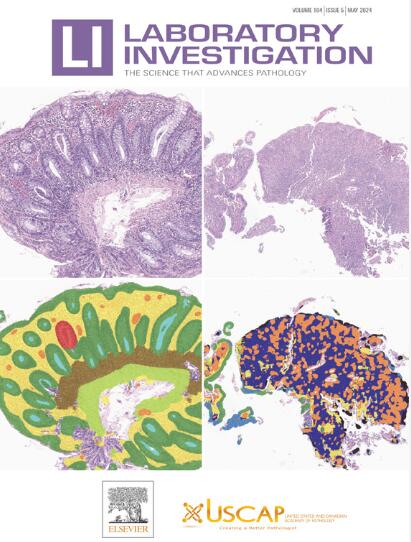数字影像平台对钙化反应诊断的确定性和可靠性的多中心评价
IF 4.2
2区 医学
Q1 MEDICINE, RESEARCH & EXPERIMENTAL
引用次数: 0
摘要
诊断钙化反应的组织病理学标准的稳健性取决于皮肤病理学家对个体组织学特征识别的信心以及这些评估的相互可靠性(IRR)。本研究的目的是通过评估一般和组织病理学特征特异性确定性和IRR来量化钙化诊断中的解释性挑战,并确定哪些特征是最可重复识别的。设计了一项在线诊断调查来评估准确性、确定性和IRR。病例资料包括20例有或无钙化反应的患者的1张苏木精、伊红和von kossa染色切片的临床影像、临床照片和整张切片。来自多个机构的皮肤病理学家独立进行诊断,并使用检查表来评估特定组织病理学特征的存在和确定性。代表16个机构的23名经委员会认证的皮肤病理学家(62%)作出回应。钙化反应病例的诊断准确率(53%对80%)和IRR (Krippendorff alpha [KA])低于模拟病例(0.171对0.257)。血管小动脉的坏死、细点状钙和内膜纤维增生最能将钙化反应与模拟物区分开来(P <;. 05)。在组织病理学特征中,溃疡(KA = 0.66)和坏死(KA = 0.46)的IRR最高,外周血周钙化(KA = 0.19)和环小动脉内膜纤维增生(KA = 0.07)的IRR最低。病理学家对正确识别每个特征是否存在的信心与IRR呈线性相关。数字成像平台可以促进罕见实体诊断一致性的多机构研究。本研究发现血管小动脉的坏死、细点状钙和内膜纤维增生是诊断钙化的最有力的组织病理学特征,尽管内膜纤维增生的一致性很低。病理学家对组织学特征主观评估的定量趋势可能有助于指导诊断指南的发展,并为医学教育提供信息。本文章由计算机程序翻译,如有差异,请以英文原文为准。
Multicenter Evaluation of Certainty and Reliability in Calciphylaxis Diagnosis Using a Digital Imaging Platform
The robustness of histopathologic criteria for diagnosing calciphylaxis depends both on dermatopathologists’ confidence in the recognition of individual histologic features and on the interrater reliability (IRR) of these assessments. The aim of this study was to quantify interpretive challenges in calciphylaxis diagnosis through the evaluation of generalized and histopathological feature-specific certainty and IRR and establish which features are most reproducibly recognized. An online diagnostic survey was designed to evaluate accuracy, certainty, and IRR. Case materials comprised a clinical vignette, clinical photograph, and whole slide imaging scans of 1 hematoxylin and eosin and von Kossa-stained section in 20 patients with or without calciphylaxis. Dermatopathologists from multiple institutions independently rendered diagnoses and used a checklist to assess the presence of and certainty in specific histopathologic features. Twenty-three board-certified dermatopathologists (62%) representing 16 institutions responded. Diagnostic accuracy (53% vs 80%) and IRR (Krippendorff alpha [KA]) were lower for calciphylaxis cases compared with mimics (0.171 vs 0.257). Necrosis, finely stippled calcium, and intimal fibroplasia of pannicular arterioles most robustly differentiated calciphylaxis from mimics (P < .05). Among histopathologic features, IRR was the highest for ulceration (KA = 0.66) and necrosis (KA = 0.46) and the lowest for perieccrine calcification (KA = 0.19) and intimal fibroplasia of pannicular arterioles (KA = 0.07). Pathologists’ confidence in correctly identifying the presence or absence of each feature correlated linearly with IRR. Digital imaging platforms can facilitate multi-institutional study of diagnostic concordance for uncommon entities. This study identified necrosis, finely stippled calcium, and intimal fibroplasia of pannicular arterioles as the most robust histopathologic features for diagnosing calciphylaxis, although inter-rater concordance for intimal fibroplasia was low. Quantitative trends in pathologists’ subjective assessments of histologic features may help guide the development of diagnostic guidelines and inform medical education.
求助全文
通过发布文献求助,成功后即可免费获取论文全文。
去求助
来源期刊

Laboratory Investigation
医学-病理学
CiteScore
8.30
自引率
0.00%
发文量
125
审稿时长
2 months
期刊介绍:
Laboratory Investigation is an international journal owned by the United States and Canadian Academy of Pathology. Laboratory Investigation offers prompt publication of high-quality original research in all biomedical disciplines relating to the understanding of human disease and the application of new methods to the diagnosis of disease. Both human and experimental studies are welcome.
 求助内容:
求助内容: 应助结果提醒方式:
应助结果提醒方式:


